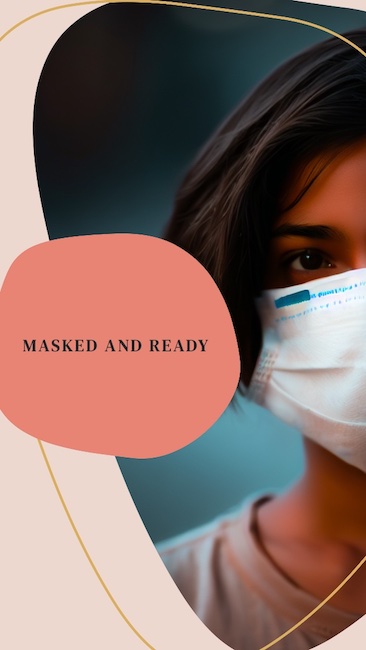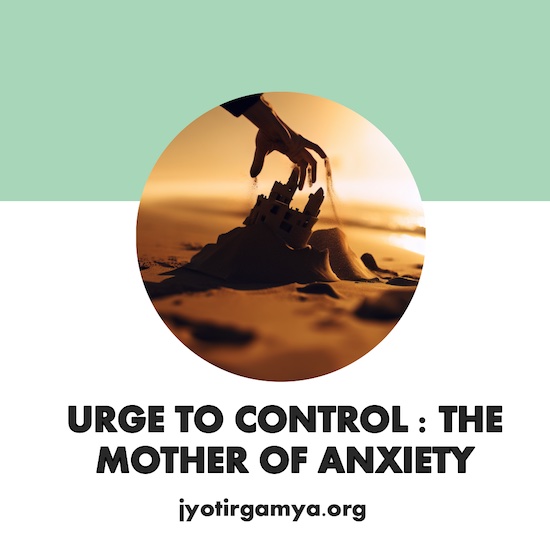Urge to Control is the Mother of Anxiety
Pamela’s Anxiety: A Gift from Her Mother
Those butterflies in the stomach. Flutters in the chest. Perhaps you felt dizzy, had a headache, or found your mind racing.
All of the above at the same time. Except, there wasn’t any cobra behind you.
Yea, no cobra.
That is how Pamela felt all the time. She had a tumultuous upbringing. There were constant fights at home, trust concerns, and ego-play between her parents. All these factors led her to develop a severe case of low self-esteem. She would always be in a state of self-doubt, questioning her abilities.
She grew up being double-faced. She lacked the confidence to speak up independently and relied on proxy mechanisms or intermediaries.
When it came to a public gathering, she would avoid it at all costs. She would barely have the courage to approach someone and speak up. Her inner voice always kept muttering,
“I am ugly."
“Nobody loves me."
“My mother is busy building a career for herself with one leg already in the graveyard."
“I am hopeless."
“I can’t work in a team."
All such negative thoughts plagued her constantly.

Sometimes, anxiety disorders run in families. The children whose parents or other caregivers consistently dismissed or ridiculed their thoughts, feelings, and ideas are more likely to struggle with poor self-esteem as adults and pass that attitude on to the next generation.
An anxious individual, therefore, desires control. They need to control everything in their lives. They have never learned to live in the moment. They hardly realize that control is a myth. The more they try to control, the more they fail and finally succumb to their Sisyphean urge, leading to more anxiety.
Introduction
Anxiety is a common human emotion that can range from mild to severe. While some anxiety can be helpful, such as when it motivates us to study for a test or prepare for a job interview, too much anxiety can be debilitating.
This article will explore how to manage anxiety, according to experts in the field of mental health. We will discuss the importance of identifying triggers, understanding the body’s response to anxiety, and developing healthy coping mechanisms.
By following the tips from these experts, you can learn to manage your anxiety and live a more fulfilling life.

Expert Advice
“The individual should be treated as a whole considering one’s physical and emotional well-being.
Therefore, I address the individual’s nutritional habits, activity level, and sleep hygiene, which can significantly impact anxiety symptoms. I also promote healthy social activities, mindfulness techniques, and Journaling to address anxiety management.
Therapy is also a practical approach to Anxiety Disorders.”
“Just like joy and happiness, anxiety and its triggers are deeply personal. What causes anxiety for me may not do so for you. So, the first step in managing anxiety is identifying our triggers. Once that is done, learn to read your body’s response to it, as our body ALWAYS gives us signals.
Once you know these signals, you’ll know when anxiety is creeping toward you before it becomes monstrous in proportion. The last step would be to use quick-relief techniques for alleviating anxiety – focused breathing, stepping away from the situation, thinking of happy memories, looking at the picture of your loved ones, listening to a song, etc.
While these can provide immediate relief, building your work and life is vital so that your well-being is always a priority – make your self-care plan, set healthy boundaries, and learn to slow down. Along with these steps, it is essential to accept that anxiety is a part of life now – a by-product of the ‘always on and hustle culture that we celebrate so much as a society. We must acknowledge its presence and leash it before it leashes us.”
“I find that explaining what anxiety is and how it works in our body helpful for people as a starting point in managing anxiety.
There’s a small part of our primitive brain called the amygdala, which acts like a watchdog. It is constantly scanning for risks and threats. This may be a real threat, but these days, it is more likely to be an emotional or psychological threat. When the amygdala fires off, our body releases adrenalin, nor-adrenaline, and cortisol (our primary stress hormone). These, along with other hormones, flood our body, getting it ready to fight the threat, run away from the threat, or freeze if there’s no escape.
This is known as the fight-flight-freeze response. The physical sensations we feel, such as rapid heartbeat, sick feeling in our stomach, sweating, tense muscles, etc., are our body reacting to the hormones. This is a normal physiological response. The other thing that happens when the amygdala fires off is our brain shuts down our frontal lobe. Our frontal lobe is the thinking, problem-solving, and rationalizing part of our brain. So, we literally can’t think clearly when we are feeling anxious.
Two strategies that are very helpful in calming the physical symptoms of anxiety and bringing our brain back online are:
-
Diaphragmatic Breathing: breathe deeply through the nose for a count of three; hold it for a count of three; slowly let it out through the mouth for a count of five. Do this sequence three or four times, and the physical anxiety symptoms should be calmed. When the physical symptoms are calmed, a message is sent to our brain saying that we have things under control, which can bring our frontal lobe back online.
-
Grounding: Tell yourself five things you can see, four things you can touch, three things you can hear, two things you can smell, and, especially if you are eating or drinking, one thing you can taste.
You need to breathe at the first sign of feeling anxious. Otherwise, the anxiety will take hold, and the breathing won’t work.
Do the breathing first to bring your brain back online so you can think to do the grounding.
Progressive Muscle Relaxation: Many people who experience anxiety have difficulty sleeping. One strategy that can help with this is Progressive Muscle Relaxation (PMR). When we’re anxious or stressed, our muscles are usually taut. PMR helps to re-teach your muscles and what it feels like to relax. It is a full-body activity in which you tighten specific muscles briefly and then release them.
In the end, you do a full-body tense, then release. It is common to fall asleep during this exercise before completing the process. You can get various apps to talk you through the PMR process. It is quick and easy to learn.
Anxiety, in itself, is a normal human emotion, just like all our other emotions. We all need certain anxiety levels to perform things that we find challenging, such as public speaking or going on a first date. The good news is that we can manage our anxiety.”
“I would look inside the person’s eye to see what the anxiety looked like in the brain. For example, anxiety could look like an electric bolt, a tight knot, or a lump of burning coal.
Once we name the internal experience of that feeling, we can find safe ground for a bolt to go, invite the knot to begin loosening up or cool down the coal.
This way, when the left logical brain looks at the right visual brain, your automatic reaction will be much different.”
“Everyone experiences anxiety; however, how we experience it may differ. People who experience it more often and intensely than others – anxiety may claim to be the only identity of a person. As a Narrative Therapist, I try to locate this problem outside of the person and how it’s impacting one’s life. Asking simple questions like:
-
What would you like to name this problem you are dealing with? (Try and choose an experience near the name.)
-
How long has it been around?
-
How do you know that it is seeping into your life? Any physiological sensation, any other signs?
-
Write down what it says to you. Does it have any voice?
-
Where does it show up? School/college, relationship, workplace?
-
Does it make you reach any conclusions about yourself?
-
Does it bring several other problems along with it?
-
What do you think are the intentions of this problem in your life?
-
Are you okay with how this problem affects your life?
-
Despite this problem, what do you still manage to do?
Answering some of the above questions helps create distance between the problem and the person. Simply put, the transformation of a single identity of “being an anxious person” to prefer “I have a relation with anxiety.”
Question 10 helps focus on the preferred identity of individuals. It helps unearth various hidden stories of their lives and how a person is trying to lower the impact of the problem in their life by taking even the minutest of actions. These conversations help people reclaim hope and dreams in their lives.”
Conclusion
Anxiety is normal, but it can become debilitating if not managed properly. There are many different ways to manage anxiety; the best approach will vary depending on the individual.
The first step in managing anxiety is to identify what triggers your anxiety. It can be helpful to understand how anxiety works in the body. Many relaxation techniques can help manage anxiety, such as deep breathing, progressive muscle relaxation, and meditation. Eating a healthy diet, regular exercise, and getting enough sleep can help reduce anxiety levels.
Remember, you are not alone. Anxiety is a common problem, and many resources are available to help you manage it.
If you are struggling with anxiety, please contact a mental health professional for help. You don’t have to go through this alone.
If someone would benefit from the article, please share it with them.
Want to stay connected? Here’s our Twitter.
Further Reading on Anxiety
Social Anxiety Disorder Treatment
Note to Younger Self on Overcoming Anxiety
Integral Somatic Psychology: New Approach to Anxiety Management